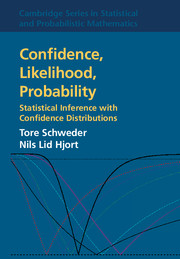Book contents
- Frontmatter
- Dedication
- Contents
- Preface
- 1 Confidence, likelihood, probability: An invitation
- 2 Inference in parametric models
- 3 Confidence distributions
- 4 Further developments for confidence distribution
- 5 Invariance, sufficiency and optimality for confidence distributions
- 6 The fiducial argument
- 7 Improved approximations for confidence distributions
- 8 Exponential families and generalised linear models
- 9 Confidence distributions in higher dimensions
- 10 Likelihoods and confidence likelihoods
- 11 Confidence in non- and semiparametric models
- 12 Predictions and confidence
- 13 Meta-analysis and combination of information
- 14 Applications
- 15 Finale: Summary, and a look into the future
- Overview of examples and data
- Appendix: Large-sample theory with applications
- References
- Name index
- Subject index
4 - Further developments for confidence distribution
Published online by Cambridge University Press: 05 March 2016
- Frontmatter
- Dedication
- Contents
- Preface
- 1 Confidence, likelihood, probability: An invitation
- 2 Inference in parametric models
- 3 Confidence distributions
- 4 Further developments for confidence distribution
- 5 Invariance, sufficiency and optimality for confidence distributions
- 6 The fiducial argument
- 7 Improved approximations for confidence distributions
- 8 Exponential families and generalised linear models
- 9 Confidence distributions in higher dimensions
- 10 Likelihoods and confidence likelihoods
- 11 Confidence in non- and semiparametric models
- 12 Predictions and confidence
- 13 Meta-analysis and combination of information
- 14 Applications
- 15 Finale: Summary, and a look into the future
- Overview of examples and data
- Appendix: Large-sample theory with applications
- References
- Name index
- Subject index
Summary
Confidence distributions were introduced, developed and broadly discussed in the previous chapter, with emphasis on typical constructions and behaviour in smooth parametric models. The present chapter considers various extensions and modifications for use in less straightforward situations. These include cases in which the parameter range of the focus parameter is bounded; the Neyman–Scott problem with a high number of nuisance parameters; the Fieller problem with a ratio of two normal means, and other cases of multimodal likelihoods; Markov chain models; and hazard rate inference.
Introduction
The likelihood machinery is and remains a very powerful and versatile toolbox for theoretical and practical statistics. Theorems 2.2 and 2.4, along with various associated results and consequences, are in constant use, for example, qua algorithms in statistical software packages that use the implied approximations to normality and to chi-squaredness. The confidence distribution methods developed in Chapter 3 also rely in part on this machinery. Along with further supplements and amendments using modified profile deviances or bootstrap techniques for improved accuracy, as investigated in Chapters 7 and 8, this may lead to broadly applicable algorithms implemented in standard statistical software packages.
In the present chapter we pursue the study of stylised and real data examples further, beyond the clearest and cleanest cases dealt with in the previous chapter. We illustrate how certain difficulties arise in cases with bounded parameters or bounded confidence, or with multimodal log-likelihoods, and extend the catalogue of confidence distributions to situations involving Markov chains and time series, hazard rate models with censored data and so forth.
Bounded parameters and bounded confidence
In Chapter 3 we illustrated the use of confidence distributions in fairly regular situations, where the distributions in question in particular have a full, natural range, with C(ψ) starting somewhere at zero and growing smoothly to one. There are important situations in which this picture needs modification, however, and we shall discuss two such general issues here. The first concerns cases where the focus parameter lies in an interval with a natural boundary, as with variance components or in situations where a priori concerns dictate that one parameter must be at least as large as another one.
- Type
- Chapter
- Information
- Confidence, Likelihood, ProbabilityStatistical Inference with Confidence Distributions, pp. 100 - 153Publisher: Cambridge University PressPrint publication year: 2016

